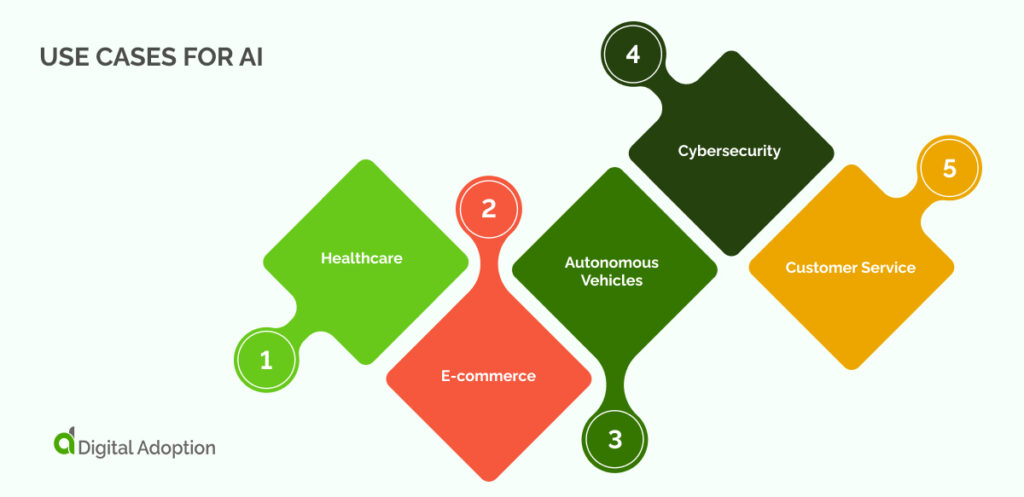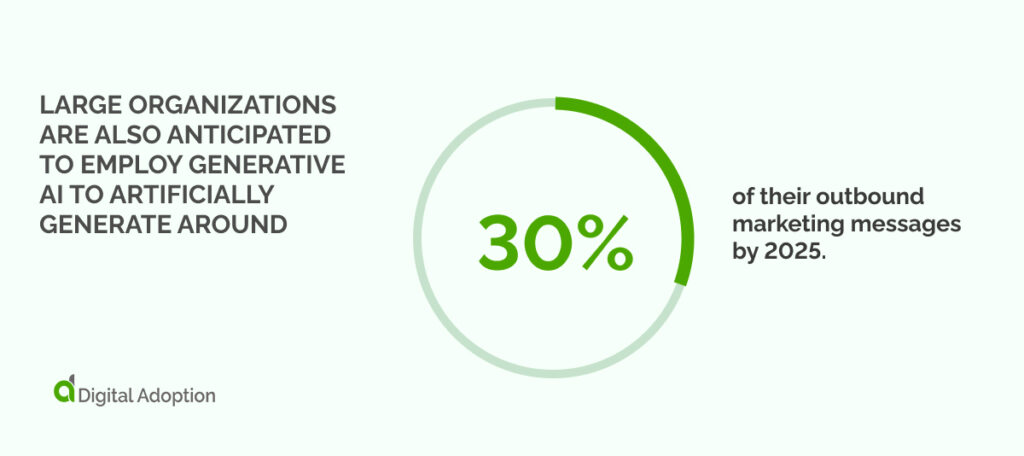Artificial Intelligence (AI) refers to machines programmed to mimic human intelligence, analyzing data to recognize patterns and make decisions.
Generative AI, a subset of AI, advances this concept by creating new content from learned data, excelling in pattern creation across various mediums like text, images, or audio.
The main difference between AI and Generative AI lies in their capabilities.
While AI is limited to analyzing existing data, Generative AI generates new content from patterns it has learned. This ability allows for endless possibilities, making it the future of technology.
According to a 2023 Statista survey of professionals in the United States, generative AI tools were utilized by 29% of Gen Z respondents, with 28% of Gen X and 27% of millennials found to have employed these tools.
And if we are talking about AI in general, the latest poll from Authority Hacker shows that 35% of businesses now use AI in some form.

The desire to acquire knowledge about AI technology is easily understandable. This is why we are exploring the difference between AI and Generative AI, their benefits, and how they are used in various industries.
By the end of this article, you will better understand both technologies and the potential applications they hold for the future.
- What Is Artificial Intelligence (AI)?
- What Is Generative AI?
- AI vs. Generative AI: What’s The Difference?
- Why Is AI Important?
- Why Is Generative AI Important?
- What are Dall-E, ChatGPT and Bard?
- What Are Use Cases For AI
- What Are The Use Cases For Generative AI
- What Can We Expect From AI & Generative AI In The Future
What Is Artificial Intelligence (AI)?
Artificial Intelligence (AI) is a dynamic field within computer science that empowers machines and software with the ability to mimic human intelligence.
AI systems can perceive, reason, learn, and interact, mirroring cognitive functions typically associated with human minds. These intelligent systems are capable of problem-solving and decision-making, often iteratively improving their performance based on the data they encounter.
AI’s broad spectrum of capabilities continues to evolve with technological advancements, enabling it to perform tasks that require human-like intelligence.
What Is Generative AI?
Generative AI is a cutting-edge technology within the field of artificial intelligence that utilizes neural networks to generate new and original content.
This advanced AI can produce a wide variety of data, including text, images, audio, videos, and 3D models. Generative AI can create content such as synthetic data, code, simulations, and more by identifying patterns and structures within existing data.
Generative AI builds upon technologies like large language models (LLMs), which are trained on vast amounts of text, enabling them to predict subsequent words in a sentence or paragraph.
Examples of generative AI applications include ChatGPT and DALL-E, algorithms capable of creating new content, including audio and other forms of media.
Generative AI is becoming increasingly popular due to its ability to produce high-quality content based on the data it was trained on. Its applications range from creating realistic text and images to generating code and simulations, making it a versatile tool in various industries.
AI vs. Generative AI: What’s The Difference?
Understanding the differences between Artificial Intelligence (AI) and Generative AI is crucial in today’s technology-driven world, as these two concepts, while intertwined, offer unique capabilities and applications in various fields.
We’ve identified the primary difference between AI and Generative AI as their capabilities:
Functionality
Traditional AI systems are designed to understand, interpret, and make decisions based on the data they have been fed. They can answer questions, recommend products, or drive cars autonomously. This is achieved through machine learning algorithms that allow these systems to learn from experience and improve over time.
Generative AI, however, goes beyond understanding and interpreting data. It generates entirely new content from scratch. For example, it can create human-like text, compose music, or create images indistinguishable from those made by humans. This is achieved through advanced deep learning models, such as Generative Adversarial Networks (GANs), which can generate new data with the same statistical properties as the training set.
Data Use
AI uses data to learn, understand patterns, and make predictions or decisions. It can analyze large amounts of data quickly and accurately, providing valuable insights and predictions.
Generative AI, on the other hand, uses data as a starting point to create entirely new data or content. It doesn’t just analyze and understand the data; it uses what it has learned to generate new, unique outputs. This can range from generating sentences for a story to creating entirely new images or designs.
Creativity
While AI excels at tasks that require logic and analysis, Generative AI takes it further. Unlike traditional AI, Generative AI is capable of tasks that involve creativity and innovation. Leveraging its learning capabilities, Generative AI can generate new ideas or content, adding an element of creativity beyond what is typically associated with traditional AI.
This ability to think outside the box and bring fresh perspectives to the table makes Generative AI a powerful tool for pushing the boundaries of innovation and unlocking new possibilities in various fields. By combining logic, analysis, and creativity, Generative AI opens up a world of untapped potential, revolutionizing how we approach problem-solving and content creation.
Applications
AI is commonly used in areas like data analysis, automation, and problem-solving. It’s behind the recommendation engines of online platforms, the autonomous driving features of smart cars, and the voice recognition and interpretation capabilities of virtual assistants.
Generative AI, due to its creative capabilities, finds its use in more artistic fields. It’s used to create art, compose new music, write stories or articles, and design products. In these fields, the ability of Generative AI to develop new, original content can be a powerful tool for innovation and creativity.
Why Is AI Important?
Artificial Intelligence (AI) is crucial due to its transformative potential across various domains. It enhances efficiency and productivity by automating routine tasks, facilitates accurate data analysis and interpretation, and enables informed decision-making.
AI’s ability to learn from data and discern patterns provides invaluable insights that can drive business growth, optimize healthcare delivery, enhance educational methods, and more.
As a catalyst for technological innovation, AI promises to open new frontiers in digital transformation.
Why Is Generative AI Important?
Generative AI is a subset of artificial intelligence that leverages machine learning techniques to produce content.
Generative AI can replicate human creativity across various domains, such as visual arts, literature, music, and programming.
This transformative technology holds immense promise in fields like art, entertainment, marketing, and software development, reshaping how we produce and engage with content.
What are Dall-E, ChatGPT and Bard?
You may have heard of the algorithms Dall-E, ChatGPT, and Bard in recent years.
These are all examples of generative AI applications that have made headlines for their innovative capabilities.

It’s important to understand the distinction between these algorithms and traditional AI systems to fully appreciate their significance:
What Is DALL-E?
DALL-E, created by OpenAI, is an AI model that pushes the boundaries of generative AI. It uses variants of GPT-3 and VQ-VAE-2 to generate images from textual descriptions. DALL-E can create completely novel images or combine disparate elements into a coherent whole.
It’s capable of generating specific visual concepts, even those that are unconventional or abstract. This technology has profound implications for digital art, design, advertising, and other fields requiring visual creativity.
What Is ChatGPT?
ChatGPT, another development from OpenAI, represents a significant advancement in conversational AI. Trained through a process called Reinforcement Learning from Human Feedback (RLHF), it can produce contextually relevant, human-like text responses.
Beyond basic conversation, ChatGPT can be used for various tasks, including drafting and editing content, brainstorming ideas, programming help, and learning new topics. Its ability to understand and generate nuanced responses could redefine how we interact with AI.
What Is Bard?
Bard is an AI tool designed to revolutionize creative writing. It utilizes advanced natural language processing techniques and machine learning algorithms to generate imaginative narratives, poems, and stories.
Users provide a prompt, and Bard creates unique, engaging content based on that input. It’s not limited to any specific genre or style, making it a versatile tool for writers, marketers, educators, and anyone needing original written content.
What Are Use Cases For AI

While AI has many use cases, we’ve chosen to focus on some of the most important ones:
Healthcare
AI in healthcare is drastically changing patient care and medical research.
AI algorithms can analyze complex medical data to identify patterns, aiding in early disease detection and diagnosis. AI-powered imaging diagnostics can interpret images to detect anomalies such as tumors, fractures, or blockages.
In drug discovery, AI can predict how different compounds behave and their potential effectiveness against diseases, significantly speeding up the pharmaceutical development process. AI also enables personalized medicine by considering individual patient characteristics, leading to more effective treatment plans.
E-commerce
In e-commerce, AI enhances both the customer journey and business operations.
AI-driven recommendation engines analyze user behavior to provide personalized product suggestions, improving conversion rates and customer loyalty.
For businesses, AI can optimize inventory management by predicting demand and reducing overstock situations. Fraud detection systems use AI to identify suspicious activity, protecting businesses and customers from cyber threats. By automating these processes, AI allows e-commerce businesses to operate more efficiently and effectively.
Autonomous Vehicles
AI is the driving force behind autonomous vehicles.
It enables these vehicles to make real-time decisions, such as identifying objects, navigating routes, and avoiding collisions. AI algorithms analyze data from various sensors to understand the vehicle’s surroundings and act accordingly.
AI can also predict vehicle maintenance needs by analyzing performance data, preventing unexpected breakdowns, and enhancing safety. As AI technology advances, we move closer to fully autonomous vehicles becoming a common part of our everyday lives.
Cybersecurity
In cybersecurity, AI plays a critical role in protecting against threats.
AI systems can analyze vast amounts of data for unusual patterns or behaviors that may signal a cyber attack. They can automate responses to these threats, significantly reducing the time between threat detection and mitigation.
AI also aids in predicting potential vulnerabilities by learning from past incidents. This proactive approach to cybersecurity helps companies stay one step ahead of cybercriminals.
Customer Service
AI is revolutionizing customer service by leveraging chatbots and virtual assistants.
These powerful AI-driven tools are available 24/7, promptly addressing customer inquiries and efficiently resolving issues. With their natural language processing capabilities, they comprehend customer queries and generate appropriate responses.
This enhances customer satisfaction through immediate assistance and enables businesses to handle more inquiries without requiring extra staff.
AI also analyzes customer interactions, uncovering valuable insights and trends that aid businesses in continuously enhancing their service.
What Are The Use Cases For Generative AI

If you think AI has already made a significant impact, then generative AI will amaze you.
Some of the most exciting use cases for generative AI include:
Content Creation
Generative AI can produce original content across various formats, including articles, blog posts, and social media updates.
It comprehends styles, themes, and structures by analyzing existing content and leveraging this knowledge to create fresh, engaging content.
This saves time and effort in content creation and ensures businesses can uphold a consistent and compelling online presence.
Art and Design
Generative AI is revolutionizing the field of art and design by leveraging its ability to create original artworks and designs or modify existing ones with stunning precision.
This groundbreaking technology has opened up endless possibilities for artists, enabling them to use generative AI as a powerful tool for exploration and experimentation, pushing the boundaries of creativity to new heights.
With generative AI as their creative companion, artists, and designers are empowered to unlock a world of endless inspiration and innovation.
Data Augmentation
In machine learning (ML), having a large and diverse dataset is crucial for training robust models that can generalize well. However, acquiring such datasets can be challenging, especially in fields where data collection is sensitive or limited, like healthcare.
This is where generative AI comes into play. By leveraging generative models, we can create synthetic data that mimics the characteristics of real-world data, thereby augmenting existing datasets and improving model performance.
This approach addresses the scarcity of data and ensures that the models can handle various scenarios and edge cases. As a result, generative AI offers a powerful solution for enhancing the accuracy and reliability of machine learning models in challenging domains.
Personalized Recommendations
Generative AI, powered by advanced machine learning algorithms, can generate highly personalized recommendations for users, taking into account their unique behavior patterns and individual preferences.
It goes beyond mere product or service recommendations, encompassing a wide range of applications such as generating tailored workout plans, personalized meal plans, curated learning resources, and so much more.
This level of personalization enhances user engagement and significantly boosts user satisfaction, providing them with precisely what they need and want, making their experience truly exceptional.
Text-to-Speech (TTS) and Speech-to-Text (STT) Conversion
Generative AI plays a crucial and transformative role in optical character recognition, Text-to-Speech (TTS), and Speech-to-Text (STT) technologies.
TTS leverages its capabilities to generate remarkably human-like speech from written text, empowering a wide range of applications such as virtual assistants, audiobooks, and accessibility tools.
On the other hand, STT excels in converting spoken language into written text, enabling various services like transcription services, voice search, and much more.
These advanced technologies enhance communication and significantly improve accessibility, fostering inclusive experiences for all.
What Can We Expect From AI & Generative AI In The Future
The future of AI and Generative AI holds tantalizing promise.
As we gaze ahead, we can see a landscape where these technologies are set to redefine productivity and the very nature of work.
Generative AI, in particular, is expected to have far-reaching impacts. It’s projected to substantially increase labor productivity across diverse sectors, with occupational categories most exposed to generative AI likely to continue adding jobs through 2030.
But it’s not just about work. The technology will open up new possibilities for real-time translation, audio dubbing, and automated voiceovers and narrations. Large organizations are also anticipated to employ generative AI to artificially generate around 30% of their outbound marketing messages by 2025.

Generative AI will foster more automation, enabling organizations to achieve more with fewer resources. By 2030, predictions suggest a significant rise in synthetically generated content, from less than 2% in 2022 to 30%.
The future of AI isn’t merely about technological advancements; it’s about shaping an innovative, efficient, and dynamic digital world.
If this hasn’t convinced you of the power of generative AI, then I don’t know what will.













